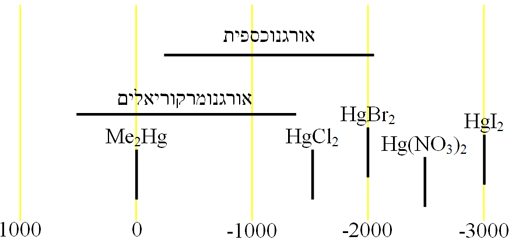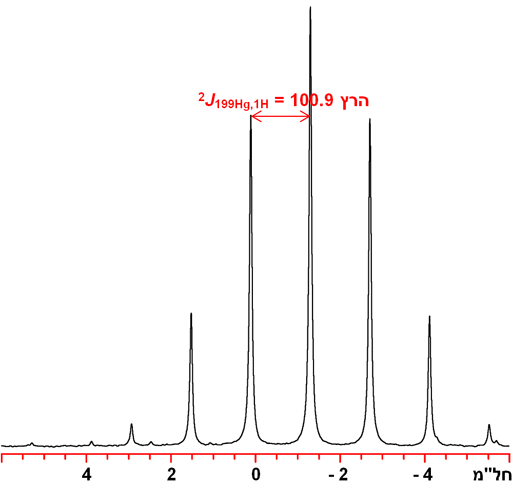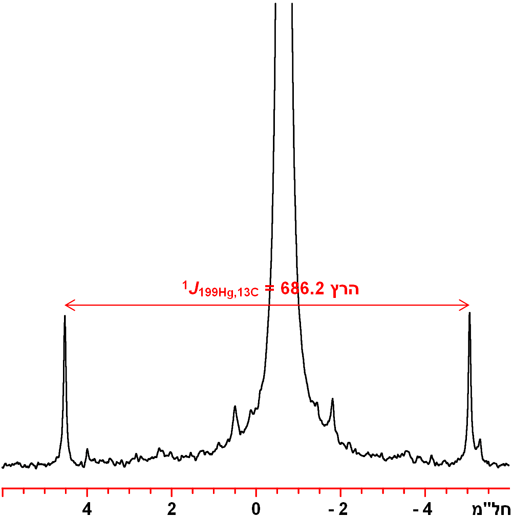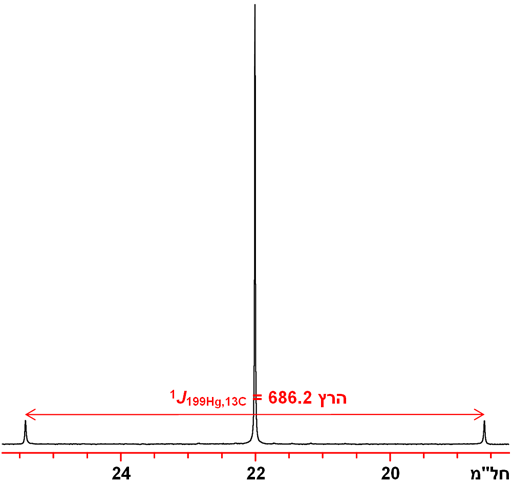תמג כספית (Hg)
לכספית יש שני גרעינים פעילי תמ" ג, 199Hg ו-201Hg. 199Hg הוא גרעין ספין חצי עם ברגישות נמוכה שנותן סיגנלים חדים פרוב על טווח היסט כימי רחב מאוד. 201Hg הוא ארבע קוטבי עם רגישות נמוכה שנותן סיגנלים רחבים מדי מכדי לראות בספקטרומטר רגילה אפילו עבור מולקולות קטנות כמו דימתיל כספית. לכן 199Hg הוא גרעין הכספית המועדף. משתמשים ב-תמ"ג 199Hg לחקור תרכובות כספית, מבניהם והדינמיקה שלהם. ניתן להשתמש בה לחקור קשר ביולוגי מתופעות הרלקסציה.
לכל סוג של תרכובת כספית יש תחום היסט כימי ייחודי (תרשים 1).
תרשים 1. טווחי היסט כימי של תמ"ג כספית

תמ"ג 199כספית
199Hg נותן סיגנלים חדים (תרשים 2) והוא יותר רגיש מ-201Hg. לכן 199Hg הוא גרעין הכספית המועדף.
תרשים 2. ספקטרום תמ"ג 199Hg עם הפרת צימוד של Me2Hg (טהור)

199Hg מרבה להראות פיצולים מגרעינים אחרים. צימוד דו-קשרי 1H-199Hg בין 100 ל-270 הרץ (תרשימים 3 ו-4). צימוד חד-קשרי ל-13C הוא בין 600 ו-3000 הרץ (תרשימים 5 ו-6), דו-קשרי בין 70 ל-130 הרץ ותלת קשרי בין 100 ו-220 הרץ.
תרשים 3. ספקטרום תמ"ג 199Hg של Me2Hg (טהור) שמראה צימוד לפרוטון

תרשים 4. ספקטרום תמ"ג 1H של Me2Hg (טהור) שמראה צימוד ל-199Hg

תרשים 5. ספקטרום תמ"ג 199Hg של Me2Hg (טהור) שמראה צימוד ל-13C

תרשים 6. ספקטרום תמ"ג 13C של Me2Hg (טהור)שמראה צימוד ל-199Hg

תכונות גרעין ה-199Hg
| תכונה | ערך |
|---|---|
| ספין | 1/2 |
| שכיחות בטבע | 16.87% |
| תחום ההיסט הכימי | 3500 ppm, בין -500 ל-3000 |
| יחס התדירויות (Ξ) | 17.910822% |
| חומר יחוס (נקודת אפס יחסית) | Me2Hg (טהור) |
| רוחב פס של חומר הייחוס | 2.6 הרץ |
| זמן התפוגה T1 של חומר הייחוס | שניות 0.5 |
| רגישות יחסית ל-1H בשכיחות טבעית | 1.00 × 10-3 |
| רגישות יחסית ל-1H כאשר מועשר | 5.93 × 10-3 |
| רגישות יחסית ל-13C בשכיחות טבעית | 5.89 |
| רגישות יחסית ל-13C כאשר מועשר | 34.9 |
תמ"ג 201כספית
201Hg הוא גרעין ארבע קוטבי שנותן סיגנלים רחבים מדי מכדי לראות סיגנלים רחבים מדי מכדי לראות בספקטרומטר רגילה אפילו עבור מולקולות קטנות כמו דימתיל כספית. בנוסף 201Hg פחות רגיש מ-199Hg. לכן 201Hg אינו גרעין הכספיתהמועדף לתמ"ג. מאחר שלא ניתן לראותו, אין לנו ניסיון שימושי ב-201Hg במעבדה שלנו.
תכונות גרעין ה-201Hg
| תכונה | ערך |
|---|---|
| ספין | 3/2 |
| שכיחות בטבע | 13.18% |
| תחום ההיסט הכימי | 3500 ppm, בין -500 ל-3000 |
| יחס התדירויות (Ξ) | 6.611583% |
| חומר יחוס (נקודת אפס יחסית) | Me2Hg (טהור) |
| רוחב פס של חומר הייחוס | >40000 הרץ |
| זמן התפוגה T1 של חומר הייחוס | שניות 0.0002 |
| רגישות יחסית ל-1H בשכיחות טבעית | 1.97 × 10-4 |
| רגישות יחסית ל-1H כאשר מועשר | 1.49 × 10-3 |
| רגישות יחסית ל-13C בשכיחות טבעית | 1.16 |
| רגישות יחסית ל-13C כאשר מועשר | 8.80 |
| פרמטר רוחב פס | 2000 fm4 |
מקורות
- V. S. Petrosyan, and O. A. Reutov, "Study of the structure and complexation of organic and inorganic derivatives of metals by means of NMR spectroscopy of heavy nuclei", Pure Appl. Chem., 37, 147-59 (1974).
- M. Borzo and G. E. Maciel, "Mercury-199 chemical shifts of organomercury compounds by Fourier transform NMR", J. Magn. Reson., 19, 279-282 (1975).
- N. K. Wilson, R. D. Zehr and P. D. Ellis, "Carbon-13 nuclear magnetic resonance. Carbon-13 chemical shifts and carbon-13-mercury-199 coupling constants for some organomercury compounds", J. Magn. Reson., 21, 437-443 (1976).
- J. L. Sudmeier and T. G. Perkins, " Studies of single 199HgII ion resonances in the active site of human carbonic anhydrase B by Fourier transform nuclear magnetic resonance", J. Am. Chem. Soc., 99, 7732-7733 (1977).
- A. J. Canty, A. Marker, P. Barron and P. C. Healy, "A mercury-199 NMR spectroscopic study of two- and three-coordinate methylmercury(II) complexes, [MeHgL]NO3", J. Organometal. Chem., 144, 371-379 (1978).
- Y. A. Strelenko, Y. G. Bundel, F. H. Kasumov, V. I. Rozenberg, O. A. Reutov and Y. A. Ustynyuk, "σ,π,-Conjugation and mercury-199 shielding constants in benzyl derivatives of mercury", J. Organometal. Chem., 159, 131-135 (1978).
- M. J. Albright and J. P. Oliver, "Studies on main group metal-transition-metal bonded compounds. 7. A mercury-199 NMR study of some Group VI transition-metal mercury compounds", J. Organometal. Chem., 172, 99-107 (1979).
- R. Colton and D. Dakternieks, "Phosphorus-31 and mercury-199 NMR studies on mercury (II) halide-tributylphosphine complexes", Aust. J. Chem., 33, 955-963 (1980).
- R. Meyer, L. Gorrichon-Guigon and P. Maroni, "Carbon-13 and mercury-199 NMR study on oxobromo- and dioxomercuric compounds", J. Organometal. Chem., 188, 11-24 (1980).
- M. F. Roberts, D. A. Vidusek and G. Bodenhausen, "Adducts of ethylmercury phosphate with amino acids studied by indirect detection of mercury-199 NMR", FEBS Lett., 117, 311-314 (1980).
- P. R. Wells and D. W. Hawker, "Mercury-199 NMR chemical shifts in substituted diphenylmercury and phenylmercuric chloride", Org. Magn. Reson., 17, 26-27 (1981).
- M. J. Albright, T. F. Schaaf, A. K. Hovland and J. P. Oliver, "Metal-silicon bonded compounds. XVIII. A mercury-199 FT NMR study of some silylmercury derivatives and selected organomercury compounds", J. Organometal. Chem., 259, 37-50 (1983).
- A. M. Bond, R. Colton, M. L. Dillon, J. E. Moir and D. R. Page, "Investigation of exchange and redox reactions of mercury dithiocarbamate complexes by electrochemical techniques at mercury electrodes, mercury-199 nuclear magnetic resonance spectrometry and mass spectrometry", Inorg. Chem., 23, 2883-2889 (1984).
- A. R. Norris and R. Kumar, "Mercury-199 NMR correlations in methylmercury(II) complexes of nucleic acid constituents and their analogs", Inorg. Chim. Acta, 93, L63-L65 (1984).
- P. A. W. Dean and R. S. Srivastava, "A multinuclear (proton, phosphorus-31, mercury-199) nuclear magnetic resonance study of some complexes of mercury (II) with ditertiary phosphines", Can. J. Chem., 63, 2829-2839 (1985).
- K. E. Rowland and R. D. Thomas, "Carbon-13 and mercury-199 NMR data for methyl-substituted diarylmercury compounds", Magn. Reson. Chem., 23, 916-919 (1985).
- G. B. Deacon, M. J. O'Connor and G. N. Stretton, "Organomercury compounds. XXVIII. The synthesis and mercury-199 NMR spectra of some unsymmetrically dimercurated arenes", Aust. J. Chem., 39, 953-962 (1986).
- B. F. Abrahams, M. Corbett, D. Dakternieks, R. W. Gable, B. F. Hoskins, E. R. T. Tiekink and G. Winter, "NMR studies of phosphine adducts of mercury and cadmium xanthates and halo xanthates. Crystal and molecular structures of Cd(S2COPr-iso)2PPh3, Hg(S2COPr-iso)2PPh3 and Hg(S2COPr-iso)2P(c-C6H11)3 (c-C6H11 = cyclohexyl)", Aust. J. Chem., 39, 1993-2001 (1986).
- L. V. Pankratov, I. M. Penyagina, L. N. Zakharov, M. N. Bochkarev, G. A. Razuvaev, Y. K. Grishin, Y. A. Ustynyuk and Y. T. Struchkov, "Reactivity of germylmercurate complexes", J. Organometal. Chem., 335, 313-322 (1987).
- M. M. Kubicki, J. Y. Le Gall, R. Pichon, J. Y. Salaun, M. Cano and J. A. Campo, "95Mo and 199Hg NMR studies on complexes containing molybdenum-mercury bonds and substituted cyclopentadienyl ligands: [(C5H5-nRn)(CO)3Mo]xHgX2-x (R = Me, n = 0, 1, 4, 5; R = Ph, n = 4; X = Cl, Br, I; x = 1, 2)", J. Organometal. Chem., 348, 349-356 (1988).
- M. Delnomdedieu, D. Georgescauld, A. Boudou and E. J. Dufourc, "Mercury-199 NMR. A tool to follow chemical speciation of mercury compounds", Bull. Magn. Reson., 11, 420 (1989).
- M. Delnomdedieu, A. Boudou, D. Georgescauld and E. J. Dufourc, "Specific interactions of mercury chloride with membranes and other ligands as revealed by mercury – NMR", Chem. Bio. Interact., 81, 243-269 (1992).
- M. Cano, J. A. Campo, J. Y. Le Gall, R. Pichon, J. Y. Salaun and M. M. Kubicki, "Molybdenum- mercury bond. NMR (mercury-199, phosphorus-31, proton) and IR study on [(C5H5)(CO)2LMoHgZ] [L = P(4-XC6H4)3 (X = F, Cl, Me, OMe), P(CH2CH3)3, P(CH2CH2CN)3; Z = Cl, I, (C5H5)(CO)2LMo] complexes", Inorg. Chim. Acta, 193, 207-212 (1992).
- L. Yang, J. Chen, X. Lei, Y. Wu and M. Song, "Substituent effect on mercury-199 chemical shifts in some bisarylmercurials and aryl(2-benzothiazolylthio)mercurials", Chem. Res. Chin. Univ., 8, 81-83 (1992).
- X. Yang, Z. Zheng, C. B. Knobler and M. F. Hawthorne, ""Anti-crown" chemistry: synthesis of [9]mercuracarborand-3 and the crystal structure of its acetonitrile complexes", J. Am. Chem. Soc., 115, 193-195 (1993).
- Y. K. Grishin, V. V. Orlov, G. A. Artamkina and Y. A. Ustynyuk, "Mercury-199 nuclear magnetic shielding constants of benzyl mercury derivatives", Zh. Organich. Khim., 30, 1601-1607 (1994).
- Y. J. Wu, S. Q. Huo, H. Z. Yuan and Y. H. Liu, "Secondary interaction and n-π conjugation in ferrocenylimine derivatives of mercury as probed by Hg-199 NMR", Main Group Chem., 1, 253-256 (1996).
- A. Berra, M. L. Di Vona, B. Floris and S. Licoccia, "199Hg NMR: a tool for direct detection of the products from acetoxymercuration of alkynes", Appl. Organometal. Chem., 14, 565-569 (2000).
- F. S. H. Vieco, N. M. Hiramatsu, E. Tedeschi, D. B. Rezende and I. P. A. Campos, "The γ-cis effect in the mercury-199 NMR spectroscopy of substituted vinylmercury halides", J. Chem. Res., Syn., 25-27 (2002).
בטיחות
הוראת בטיחות: חלק מהחומרים המוזכרים כאן מסוכנים מאוד, יש להתייעץ עם נאמן בטיחות או כימאי לפני העבודה אתם . כאשר החומרים אינם מוכרים על נאמן הבטיחות או הכימאי לחפש בספרות המקצועית מידע בקשר אליהם. הממסים המשמשים לבדיקות תמ"ג הם ברובם דליקים ורעילים. TMS לדוגמא רעיל ודליק, יש להשתמש בכפפות ולעבוד במנדף. בחיוחד, מלחי כספית רעילים מאוד: כבוש כפפות מגן ועבוד במנדף. דמתיל כספית ואורגנוכספיתות אחרות מאוד רעילים (LD50 Me2Hg, 0.1 mL!): לבוש ביגוד מגן ועבוד במנדף. כפפות לטקס לא מגנים. יש לכבוש כפפות למינט עם מניעה טובה (SilverShield או 4H) מתחת לכפפות ניטרילף ניאופרין וכדו' ארוכות. טיפה אחת עלולה להרוג.